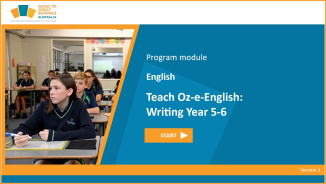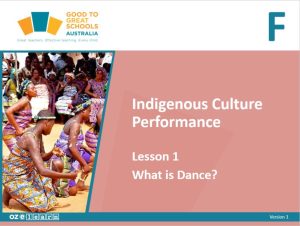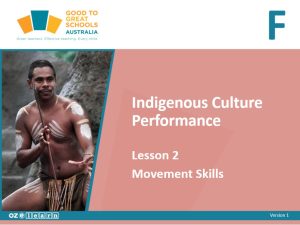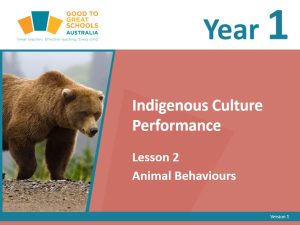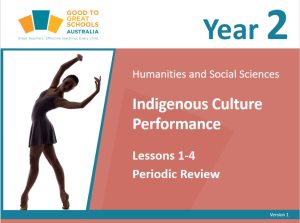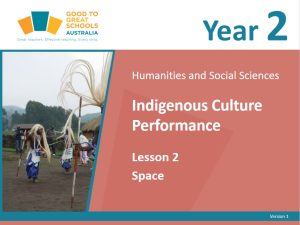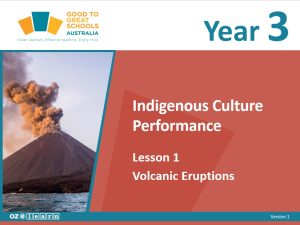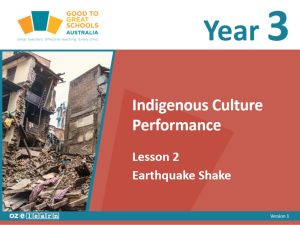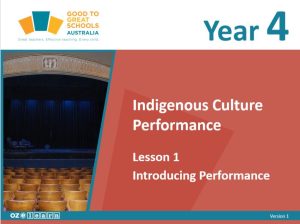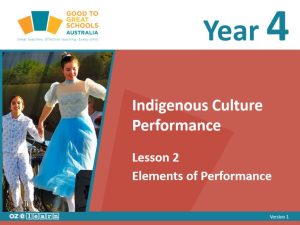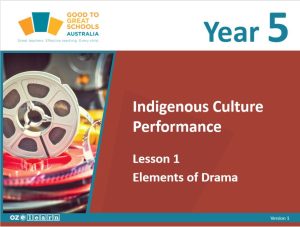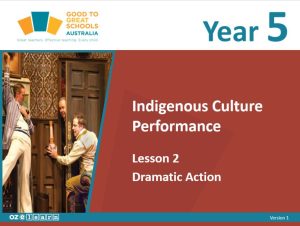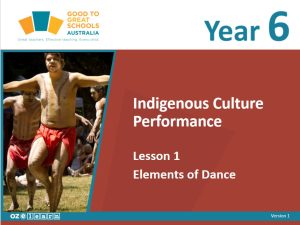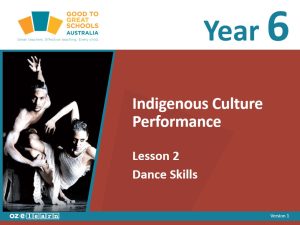Indigenous Culture Performance
Years F–6
Free Starter Lessons
Year Overview
Foundation Year – Introducing Dance and Drama
Australian Curriculum Content Descriptions
Overview
Students learn to define dance and drama, and describe where and why they’re made, including within their local community. They identify the key elements of dance and drama. Students discover basic movement skills before applying them during dance sequences. They learn to take on a role and setting in drama. Students use their own ideas to create and perform dances and dramas in front of an audience.
Learning Objectives
In Lessons 1 to 7, students learn to:
- find the four parts of dance
- find and show movement skills
- make a dance sequence
- perform a dance sequence
- find the six parts of drama
- create a drama
- tell a story using drama.
Assessment
- Content Test 1 (Dance) to be completed during Lesson 4
- Content Test 2 (Drama) to be completed during Lesson 8
- Performance Task 1 (Dance) to be progressively completed during Lessons 2, 3 and 4
- Performance Task 2 (Dance) to be completed during Lesson 7
Complete This Unit
Lesson 1: What is Dance?
Lesson 2: Movement Skills
Lesson 3: Creating Dance
Lesson 4: Performing Dance
Lesson 5: What is Drama?
Lesson 6: Creating Drama
Lesson 7: Presenting Drama
Year 1 – Telling Stories
Australian Curriculum Content Descriptions
Overview
Students explore storytelling through dramatic play, retelling common stories and creating stories based on feelings.
Learning Objectives
In Lessons 1 to 12, students learn to:
- use their facial expressions to show feelings
- use their bodies to represent an animal
- create a series of freeze-frames in character
- use their voices to create character
- retell a story in character
- retell an Indigenous story in character
- identify the main idea of a story
- tell a personal feeling story
- create a freeze-frame feelings story
- create a performance about friendship
- use storyboards to plan a performance
- perform a monologue in character.
Assessment
- Knowledge and Understanding Interview (Lesson 12)
- Assessment Task: Performance (Lessons 10–12)
Complete This Unit
Lesson 1: Emotive Expressions
Lesson 2: Animal Behaviours
Lesson 3: Freeze-Frames
Lesson 4: Character Voices
Lesson 5: Retelling Stories
Lesson 6: Retelling Indigenous Stories
Lesson 7: Main Ideas in Stories
Lesson 8: Feeling Stories
Lesson 9: Freeze-Frame Feelings
Lesson 10: Friendship
Lesson 11: Planning Performances
Lesson 12: Monologue
Year 2 – What is Dance?
Australian Curriculum Content Descriptions
Overview
Students respond to dance and recognize that people use dance to share their ideas and stories in their local community and throughout Australia. They learn to describe the effects that the elements of dance can have in communicating ideas during a dance sequence. Students are taught fundamental dance skills during practice and performance. They use their ideas to create a dance sequence and perform in front of an audience.
Learning Objectives
In Lessons 1 to 12, students learn to:
- consider where and why people dance in Australia
- describe the effect of space in dance
- describe the effect of time in dance
- describe the effect of dynamics in dance
- describe the effect of relationships in dance
- identify safe and unsafe dance practices
- explore movements safely to improvise dance ideas
- express ideas through improvised movements to music
- interpret and respond to a dance
- recognise and perform patterns of movement in dance
- plan a group dance sequence that represents a part of an Australian story
- perform a sequence of dance movements to tell a shared story and present it in digital format.
Assessment
- Knowledge and Understanding Test (Lesson 10)
- Assessment Task (Lessons 10–12)
Complete This Unit
Lesson 1: What is Dance?
Lesson 2: Elements of Dance: Space
Lesson 3: Elements of Dance: Time
Lesson 4: Elements of Dance: Dynamics
Lesson 5: Elements of Dance: Relationships
Lesson 6: Safe Movement
Lesson 7: Exploring Movement
Lesson 8: Improvising Movement
Lesson 9: Interpreting Dance
Lesson 10: Patterns in Dance
Lesson 11: Plan a Group Dance
Lesson 12: Performing a Dance
Year 3 – Improving Our Dance
Australian Curriculum Content Descriptions
Overview
Students describe and discuss similarities and differences between dances. They recognise the effect of the elements of dance on the story or mood, as well as how media can help us to tell stories. Students learn to choreograph a sequence of dance moves and demonstrate skills in practicing the moves. They learn to photograph dance in order to improve, before performing for an audience.
Learning Objectives
In Lessons 1 to 12, students learn to:
- improvise and create movements with a partner to create a short dance motif to represent the different stages in a volcanic eruption
- create and perform imaginative movements in response to different stimuli
- develop new dance moves while working in small groups
- show awareness of objects and people around them by taking responsibility for safe dance practices
- show a build-up of elements and performance to build suspense and engagement in a dance piece
- work as a group using the elements of space to show how a cyclone moves
- select a terrain on Earth to represent through locomotor and non-locomotor movements
- create and perform a dance with a partner that shows feelings and emotions
- work in a group to link actions to create a dance montage
- demonstrate performance and audience etiquette
- perform a choreographed dance to an audience
- reflect on their creative process and refine their performance.
Assessment
- Knowledge and Understanding Test (Lesson 10)
- Assessment Task (Lessons 10–12)
Complete This Unit
Lesson 1: Volcanic Eruptions
Lesson 2: Earthquake Shake
Lesson 3: Tsunami Expression
Lesson 4: Tornado Twisters
Lesson 5: Bushfire Rage
Lesson 6: Cyclonic Storm
Lesson 7: Terrain
Lesson 8: Natural Disasters 1
Lesson 9: Natural Disasters 2
Lesson 10: Performance and Audience Etiquette
Lesson 11: Performing a Choreographed Dance
Lesson 12: Evaluate Our Dance
Year 4 – Becoming Performers
Australian Curriculum Content Descriptions
Overview
Students explore drama, its types and how it can be made. They create their own drama, employing the elements of drama and working in groups. Students communicate through performing drama and reflect on their own and others’ performances.
Learning Objectives
In Lessons 1 to 11, students learn to:
- identify what performance is and its purpose
- recognise the elements of performance
- identify the place and time of various settings
- create facial expression to develop characters
- develop movements that enhance characters
- use voice and dialogue to create interesting characters
- recognise tension in performance
- recognise focus in performance
- compare and contrast the elements of performance
- look over the assessment and discuss
- demonstrate knowledge and understanding of the concepts taught throughout the unit.
Assessment
- Knowledge and Understanding Questionnaire (Lesson 12)
- Assessment Task (Lesson 12)
Complete This Unit
Lesson 1: Introducing Performance
Lesson 2: Elements of Performance
Lesson 3: Place and Time
Lesson 4: Facial Expressions
Lesson 5: Movement and Gestures
Lesson 6: Voice and Dialogue
Lesson 7: Creating Excitement with Tension
Lesson 8: Focus in Performance
Lesson 9: Comparing Performance
Lesson 10: Introduce Assessment and Discuss
Lesson 11: Group Work
Year 5 – Performing for Audience
Australian Curriculum Content Descriptions
Overview
Students explore and explain how dramatic action and meaning are communicated through drama they view, create and perform. They consider how drama and media artworks from different times, places and culture influence their own and others’ drama and media artworks.
Students collaborate to create and perform a documentary that employs both drama and media elements, dramatic action and meaning in a specific and purposeful context. They develop a script, produce media materials, and reflect on and evaluate the meaning and influences on both their own and others’ documentaries.
Learning Objectives
In Lessons 1 to 12, students learn to:
- identify the elements of drama
- create a dramatic action freeze frame
- reflect on and evaluate the use of dramatic action
- identify, consider and explain how meaning is communicated in drama
- recognise the features and purpose and of a documentary drama
- collaboratively develop a script for a documentary drama
- rehearse drama that develops narrative and drives dramatic tension
- create and record visual and auditory elements to enhance their drama
- create a poster to advertise their documentary
- create an iMovie trailer for their documentary
- present a live performance of their documentary
- evaluate others’ documentaries
- reflect on the making, advertisement and performance of their documentaries
- video and photograph their drama performances using natural disasters as stimulus.
Assessment
- Assessment Task (Lessons 5–12)
Complete This Unit
Lesson 1: Elements of Drama
Lesson 2: Dramatic Action
Lesson 3: Dramatic Communication
Lesson 4: Documentary Drama
Lesson 5: Scripting a Drama
Lesson 6: Rehearsing a Drama
Lesson 7: Media Elements
Lesson 8: Media Materials
Lesson 9: Documentary Trailer (optional)
Lesson 10: Documentary Performance
Lesson 11: Documentary Reflection
Lesson 12: Flexible
Year 6 – Communication Through Dance
Australian Curriculum Content Descriptions
Overview
Students learn to explain how the elements of dance, choreographic devices and production elements communicate meaning in dances. They describe and compare the characteristics of dances from different countries and cultures from the past, in the present day and, potentially, into the future.
Students collaborate to structure movements in dance sequences and demonstrate dance skills in practising for and performing them for an audience.
Learning Objectives
In Lessons 1 to 7, students learn to:
- explain how elements of dance communicate meaning
- identify and demonstrate technical and expressive skills
- explain how choreographic devices communicate meaning in dance
- explain how production elements communicate meaning in dance
- describe dances from different contexts
- collaborate to plan movements in dance sequences
- demonstrate dance skills in a performance.
Assessment
- Content test to be completed during Lesson 8.
- Dance sequence to be performed during Lesson 7
Complete This Unit
Lesson 1: Elements of Dance
Lesson 2: Dance Skills
Lesson 3: Choreographic Devices
Lesson 4: Production Elements
Lesson 5: Describing Dance
Lesson 6: Creating Dance
Lesson 7: Audience and Dance
Other Units
Lesson Design
Lesson Objective
Success Criteria
Activating Prior Knowledge
I Do
We Do
Apple Question
You Do
Revise
Professional Learning
